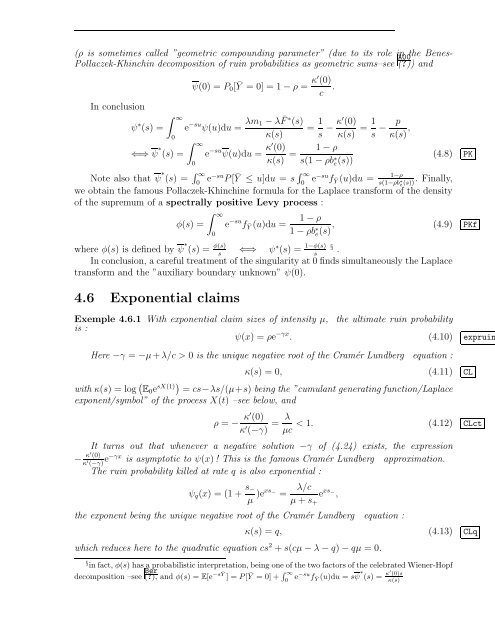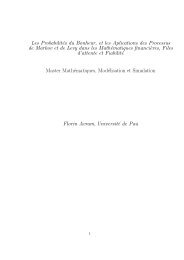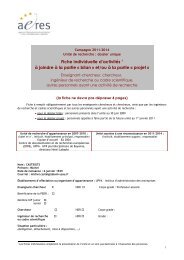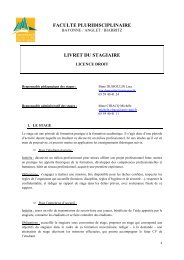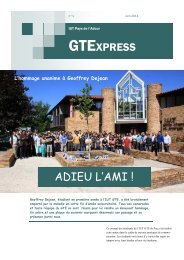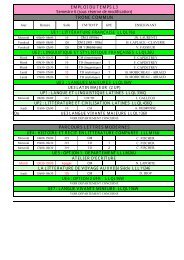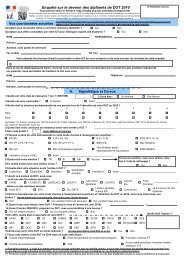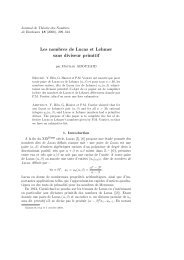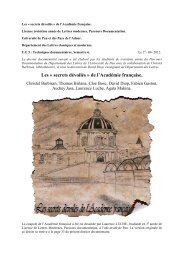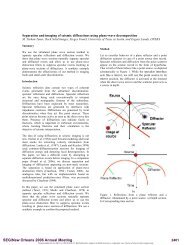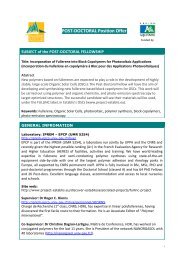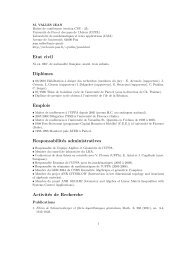Processus de Markov, de Levy, Files d'attente, Actuariat et Fiabilité ...
Processus de Markov, de Levy, Files d'attente, Actuariat et Fiabilité ...
Processus de Markov, de Levy, Files d'attente, Actuariat et Fiabilité ...
You also want an ePaper? Increase the reach of your titles
YUMPU automatically turns print PDFs into web optimized ePapers that Google loves.
(ρ is som<strong>et</strong>imes called ”geom<strong>et</strong>ric compounding param<strong>et</strong>er” (due to its role in the Benes-<br />
Pollaczek-Khinchin <strong>de</strong>composition of ruin probabilities as geom<strong>et</strong>ric sums–see (?)) A00 and<br />
In conclusion<br />
ψ ∗ (s) =<br />
∫ ∞<br />
0<br />
⇐⇒ ψ ∗ (s) =<br />
ψ(0) = P 0 [Ȳ = 0] = 1 − ρ = κ′ (0)<br />
.<br />
c<br />
e −su ψ(u)du = λm 1 − λ ¯F ∗ (s)<br />
= 1 κ(s) s − κ′ (0)<br />
κ(s) = 1 s − p<br />
κ(s) ,<br />
∫ ∞<br />
0<br />
e −su ψ(u)du = κ′ (0)<br />
κ(s) =<br />
1 − ρ<br />
s(1 − ρb ∗ e (s)) (4.8) PK<br />
Note also that ψ ∗ (s) = ∫ ∞<br />
e −su P[Ȳ ≤ u]du = s ∫ ∞<br />
e −su 1−ρ<br />
f<br />
0 0 Ȳ (u)du =<br />
s(1−ρb ∗ e (s)).<br />
Finally,<br />
we obtain the famous Pollaczek-Khinchine formula for the Laplace transform of the <strong>de</strong>nsity<br />
of the supremum of a spectrally positive <strong>Levy</strong> process :<br />
φ(s) =<br />
∫ ∞<br />
0<br />
e −su f Ȳ (u)du =<br />
1 − ρ<br />
(4.9)<br />
1 − ρb ∗ PKf<br />
e (s),<br />
where φ(s) is <strong>de</strong>fined by ψ ∗ (s) = φ(s) ⇐⇒ ψ ∗ (s) = 1−φ(s) § .<br />
s s<br />
In conclusion, a careful treatment of the singularity at 0 finds simultaneously the Laplace<br />
transform and the ”auxiliary boundary unknown” ψ(0).<br />
4.6 Exponential claims<br />
Exemple 4.6.1 With exponential claim sizes of intensity µ, the ultimate ruin probability<br />
is :<br />
ψ(x) = ρe −γx . (4.10) expruin<br />
Here −γ = −µ+λ/c > 0 is the unique negative root of the Cramér Lundberg equation :<br />
κ(s) = 0, (4.11) CL<br />
with κ(s) = log ( E 0 e sX(1)) = cs−λs/(µ+s) being the ”cumulant generating function/Laplace<br />
exponent/symbol” of the process X(t) –see below, and<br />
ρ = − κ′ (0)<br />
κ ′ (−γ) = λ < 1. (4.12) CLct<br />
µc<br />
It turns out that whenever a negative solution −γ of (4.24) exists, the expression<br />
− κ′ (0)<br />
κ ′ (−γ) e−γx is asymptotic to ψ(x)! This is the famous Cramér Lundberg approximation.<br />
The ruin probability killed at rate q is also exponential :<br />
ψ q (x) = (1 + s −<br />
µ )exs −<br />
= λ/c<br />
µ + s +<br />
e xs −<br />
,<br />
the exponent being the unique negative root of the Cramér Lundberg equation :<br />
κ(s) = q, (4.13) CLq<br />
which reduces here to the quadratic equation cs 2 + s(cµ − λ − q) − qµ = 0.<br />
§ in fact, φ(s) has a probabilistic interpr<strong>et</strong>ation, being one of the two factors of the celebrated Wiener-Hopf<br />
<strong>de</strong>composition –see (?), Ber and φ(s) = E[e −sȲ ] = P[Ȳ = 0] + ∫ ∞<br />
0<br />
e −su f Ȳ (u)du = sψ ∗ (s) = κ′ (0)s<br />
κ(s)


